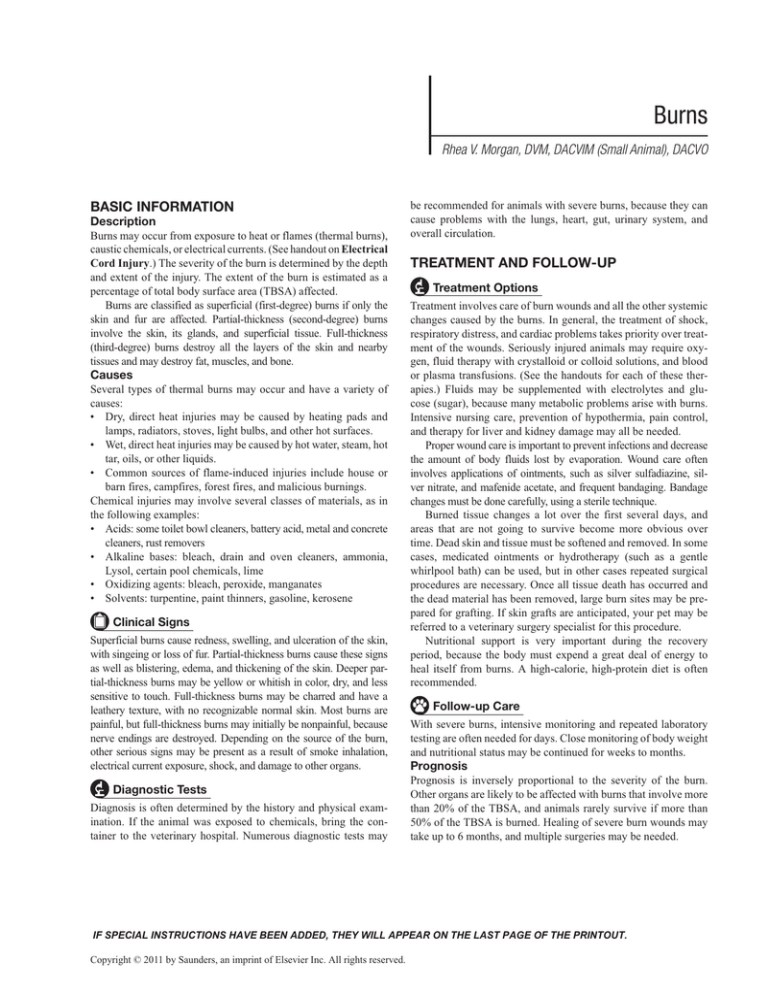
Burns
Rhea V. Morgan, DVM, DACVIM (Small Animal), DACVO
BASIC INFORMATION
Description
Burns may occur from exposure to heat or flames (thermal burns),
caustic chemicals, or electrical currents. (See handout on Electrical
Cord Injury.) The severity of the burn is determined by the depth
and extent of the injury. The extent of the burn is estimated as a
percentage of total body surface area (TBSA) affected.
Burns are classified as superficial (first-degree) burns if only the
skin and fur are affected. Partial-thickness (second-degree) burns
involve the skin, its glands, and superficial tissue. Full-thickness
(third-degree) burns destroy all the layers of the skin and nearby
tissues and may destroy fat, muscles, and bone.
Causes
Several types of thermal burns may occur and have a variety of
causes:
• Dry, direct heat injuries may be caused by heating pads and
lamps, radiators, stoves, light bulbs, and other hot surfaces.
• Wet, direct heat injuries may be caused by hot water, steam, hot
tar, oils, or other liquids.
• Common sources of flame-induced injuries include house or
barn fires, campfires, forest fires, and malicious burnings.
Chemical injuries may involve several classes of materials, as in
the following examples:
• Acids: some toilet bowl cleaners, battery acid, metal and concrete
cleaners, rust removers
• Alkaline bases: bleach, drain and oven cleaners, ammonia,
Lysol, certain pool chemicals, lime
• Oxidizing agents: bleach, peroxide, manganates
• Solvents: turpentine, paint thinners, gasoline, kerosene
Clinical Signs
Superficial burns cause redness, swelling, and ulceration of the skin,
with singeing or loss of fur. Partial-thickness burns cause these signs
as well as blistering, edema, and thickening of the skin. Deeper partial-thickness burns may be yellow or whitish in color, dry, and less
sensitive to touch. Full-thickness burns may be charred and have a
leathery texture, with no recognizable normal skin. Most burns are
painful, but full-thickness burns may initially be nonpainful, because
nerve endings are destroyed. Depending on the source of the burn,
other serious signs may be present as a result of smoke inhalation,
electrical current exposure, shock, and damage to other organs.
Diagnostic Tests
Diagnosis is often determined by the history and physical examination. If the animal was exposed to chemicals, bring the container to the veterinary hospital. Numerous diagnostic tests may
be recommended for animals with severe burns, because they can
cause problems with the lungs, heart, gut, urinary system, and
overall circulation.
TREATMENT AND FOLLOW-UP
Treatment Options
Treatment involves care of burn wounds and all the other systemic
changes caused by the burns. In general, the treatment of shock,
respiratory distress, and cardiac problems takes priority over treatment of the wounds. Seriously injured animals may require oxygen, fluid therapy with crystalloid or colloid solutions, and blood
or plasma transfusions. (See the handouts for each of these therapies.) Fluids may be supplemented with electrolytes and glucose (sugar), because many metabolic problems arise with burns.
Intensive nursing care, prevention of hypothermia, pain control,
and therapy for liver and kidney damage may all be needed.
Proper wound care is important to prevent infections and decrease
the amount of body fluids lost by evaporation. Wound care often
involves applications of ointments, such as silver sulfadiazine, silver nitrate, and mafenide acetate, and frequent bandaging. Bandage
changes must be done carefully, using a sterile technique.
Burned tissue changes a lot over the first several days, and
areas that are not going to survive become more obvious over
time. Dead skin and tissue must be softened and removed. In some
cases, medicated ointments or hydrotherapy (such as a gentle
whirlpool bath) can be used, but in other cases repeated surgical
procedures are necessary. Once all tissue death has occurred and
the dead material has been removed, large burn sites may be prepared for grafting. If skin grafts are anticipated, your pet may be
referred to a veterinary surgery specialist for this procedure.
Nutritional support is very important during the recovery
period, because the body must expend a great deal of energy to
heal itself from burns. A high-calorie, high-protein diet is often
recommended.
Follow-up Care
With severe burns, intensive monitoring and repeated laboratory
testing are often needed for days. Close monitoring of body weight
and nutritional status may be continued for weeks to months.
Prognosis
Prognosis is inversely proportional to the severity of the burn.
Other organs are likely to be affected with burns that involve more
than 20% of the TBSA, and animals rarely survive if more than
50% of the TBSA is burned. Healing of severe burn wounds may
take up to 6 months, and multiple surgeries may be needed.
IF SPECIAL INSTRUCTIONS HAVE BEEN ADDED, THEY WILL APPEAR ON THE LAST PAGE OF THE PRINTOUT.
Copyright © 2011 by Saunders, an imprint of Elsevier Inc. All rights reserved.




